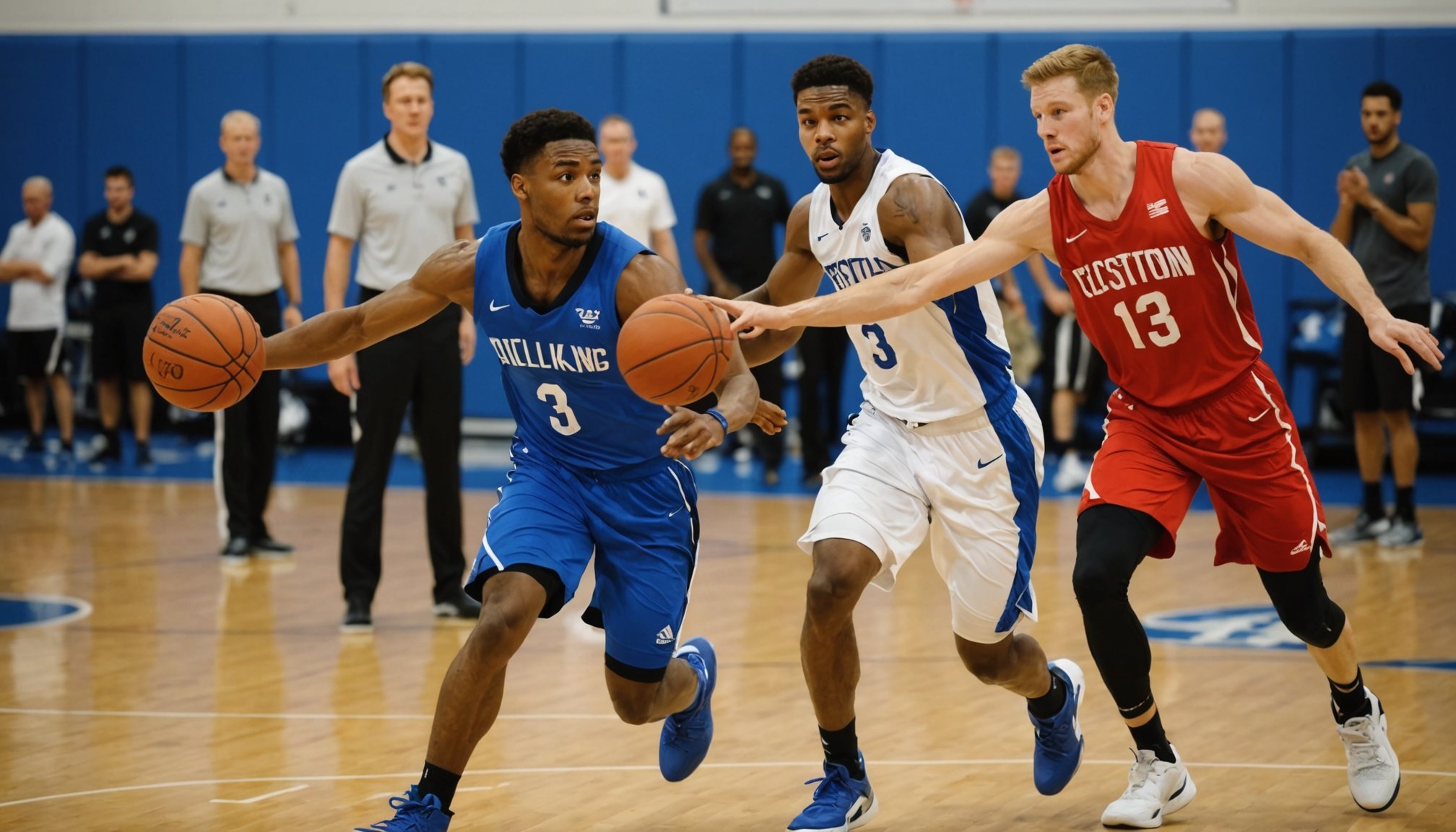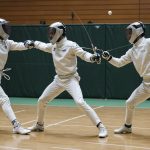Actionable Training Tactics
Training strategies in basketball focus on the development of both individual skills and team dynamics. To enhance skill development, it is crucial to incorporate a variety of basketball drills. These drills are tailored to improve essential abilities such as ball-handling, shooting, and passing.
For instance, ball-handling drills like dribbling through cones enhance hand-eye coordination and control. Shooting exercises, such as spot shooting or free throws, focus on precision and consistency. Passing drills, on the other hand, develop quick decision-making and teamwork, key components in a fast-paced game.
Have you seen this : Boosting team performance during half-time: essential strategies for uk basketball coaches
Individual training versus team training demands a balanced approach. While individual focused sessions allow players to improve specific weaknesses, team activities foster communication and strategic thinking. Emphasizing group drills can help align the team’s tactics during a real match.
The importance of these training strategies lies in their versatility and the capacity to be adjusted to each athlete’s needs. Coaches often adapt their training regimen based on player evaluations, ensuring that each session contributes meaningfully to overall progress.
This might interest you : Global talent recruitment for uk basketball academies: innovative approaches to unlock international potential
In conclusion, employing a combination of individualized focus with collective drills creates a comprehensive training regime that promotes skill enhancement and prepares athletes for competitive play.
Strength Training and Conditioning
Strength training is a critical component in the performance enhancement of basketball athletes. It focuses on building muscle strength, endurance, and power through a variety of exercises tailored to the sport’s demands. Key exercises include squats, deadlifts, and bench presses, which are crucial for building the lower and upper body strength needed for explosive moves such as jumping and sprinting.
Conditioning exercises go hand in hand with strength training, ensuring athletes maintain high levels of agility and flexibility on the court. Drills like ladder exercises and shuttle runs improve quick footwork, which is essential for defensive maneuvers and fast breaks. Flexibility routines involving stretching and yoga can help reduce the risk of injury and aid in muscle recovery.
Sample conditioning routines for basketball include interval training, combining short bursts of high-intensity activity with low-intensity recovery periods. This mimics the game’s pace and helps athletes improve their stamina and cardiovascular health.
Incorporating both strength and conditioning into training regimens is crucial for optimizing basketball performance. This balanced approach enables athletes to enhance their physical capabilities, maintain agility, and adapt to the dynamic demands of the game, ultimately leading to improved performance on the court.
Nutrition Strategies for Athletes
Athletes must adhere to specific nutrition guidelines to achieve peak performance levels during training and competitions. Essential nutrients, including carbohydrates, proteins, and fats, are fundamental components of an athlete’s diet. Carbohydrates are crucial as they provide energy for high-intensity activities, while proteins aid in muscle repair and growth. Healthy fats support essential body functions and add to the energy reserves.
Meal planning is a significant aspect of these guidelines. On training days, athletes should focus on meals that provide sustained energy, such as whole grains and lean proteins. Meanwhile, competition days necessitate easily digestible foods that optimise performance without causing fatigue or discomfort, like fruits and high-quality protein sources.
Equally crucial is the role of hydration techniques. Adequate hydration prevents fatigue, maintains cognitive function, and regulates body temperature. It is advisable to consume balanced electrolytes alongside water, especially during extended practices or matches.
During tournaments, maintaining energy levels through nutrition ensures endurance and sharpness throughout the game. By integrating these nutrition guidelines meticulously, athletes can safeguard their health and performance, turning their dietary habits into a strategic advantage on the court.
Mental Conditioning Techniques
In basketball, developing mental toughness is as critical as physical prowess. Mental resilience is key during high-pressure situations like crucial game moments or tied scores. Athletes can use focus strategies to maintain concentration amidst distractions. Techniques such as controlled breathing and mindfulness practices can help calm nerves and sharpen attention.
One effective method for enhancing performance is visualization exercises. By vividly imagining successful plays and correct techniques, athletes prepare mentally for real-game scenarios. Visualization helps in creating mental blueprints for success that translate into physical performance. Consistently practicing mental rehearsal enables athletes to block out negative thoughts and focus on executing skills accurately.
Maintaining focus during games and training requires setting clear, actionable goals. Athletes can benefit from breaking larger objectives into smaller, manageable tasks, allowing them to stay engaged and motivated. Techniques like concentration grids or attention drills can also help train the mind to remain sharp and attentive.
Ultimately, developing mental conditioning is about equipping athletes with the tools needed to perform consistently under pressure. By incorporating mental toughness exercises and visualization methods, basketball players can enhance their cognitive skills, boosting their on-court performance and competitive edge.
Recovery Methods and Injury Prevention
In the high-impact sport of basketball, prioritising recovery techniques is essential for maintaining peak performance and preventing downtime from injuries. One of the key strategies involves the use of active recovery, where activities like light jogging or swimming promote blood flow and reduce muscle soreness post-training. These techniques assist athletes in recuperating effectively between intense sessions.
Preventing common basketball injuries, such as ankle sprains and knee issues, requires a proactive approach. Incorporating specific strength exercises, like calf raises for ankle support or lunges for knee stability, can drastically reduce the risk. Additionally, ensuring athletes always warm up with dynamic stretches can prepare muscles for the rigours of the game and lower injury incidences.
Physical therapy plays a pivotal role in both recovery and injury prevention. Regular visits to a physical therapist can help athletes identify potential weaknesses and imbalances, crafting tailored exercises to address them. This aspect of the training regimen not only aids in recovery but also equips players with the strategies needed to maintain long-term health and performance.
Employing these methods ensures athletes are ready to meet the sport’s demands, performing at their best while minimizing injury risks. Integrating recovery and prevention strategies harmonises physical exertion with necessary recuperation, boosting overall basketball longevity and effectiveness.
Performance Analysis and Feedback
In basketball, performance analysis is crucial for understanding an athlete’s development and making informed adjustments to training regimens. By evaluating player stats, shooting accuracy, and movement efficiency, coaches can gain insights into areas that need improvement. This process involves using advanced tools and technology to track athletic performance precisely.
Several digital tools offer detailed analytics, such as wearable sensors and video analysis software, to monitor individual and team performances. These technologies provide real-time data, enabling coaches to identify patterns and make tactical decisions swiftly. For example, motion capture systems can break down complex plays, highlighting areas where players can enhance their technique or decision-making.
Feedback mechanisms are equally important in refining an athlete’s skills. Constructive feedback from coaches and peers can provide valuable guidance, encouraging players to adapt and improve. Regular check-ins and evaluations help set realistic goals, fostering a growth mindset within the team.
Coaching insights are instrumental in translating performance data into actionable strategies. Coaches who harness these insights can tailor training programs to address specific weaknesses, ultimately elevating the team’s overall performance. By integrating performance analysis with consistent feedback, athletes can develop more effectively, achieving higher levels of success on the court.











